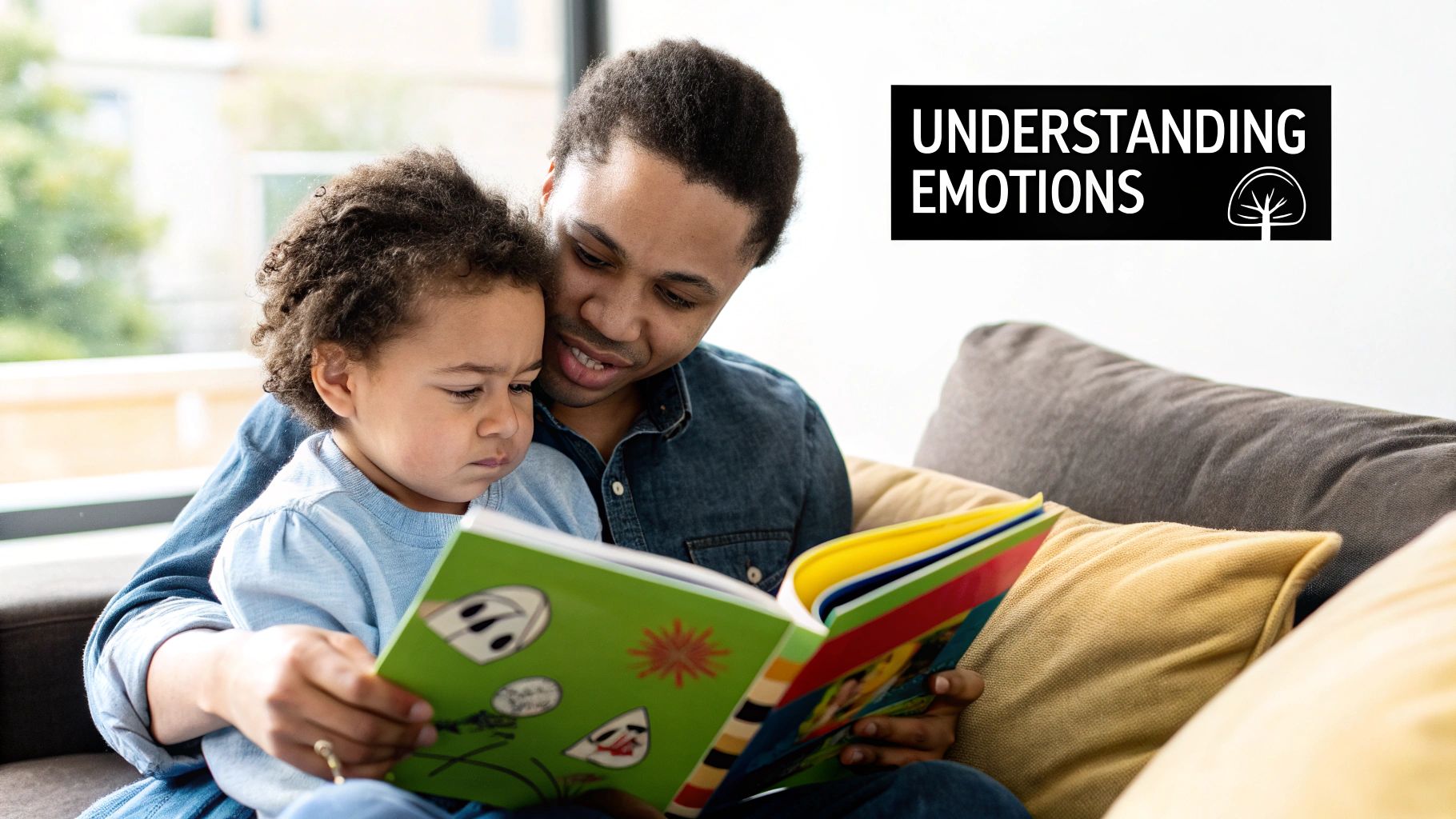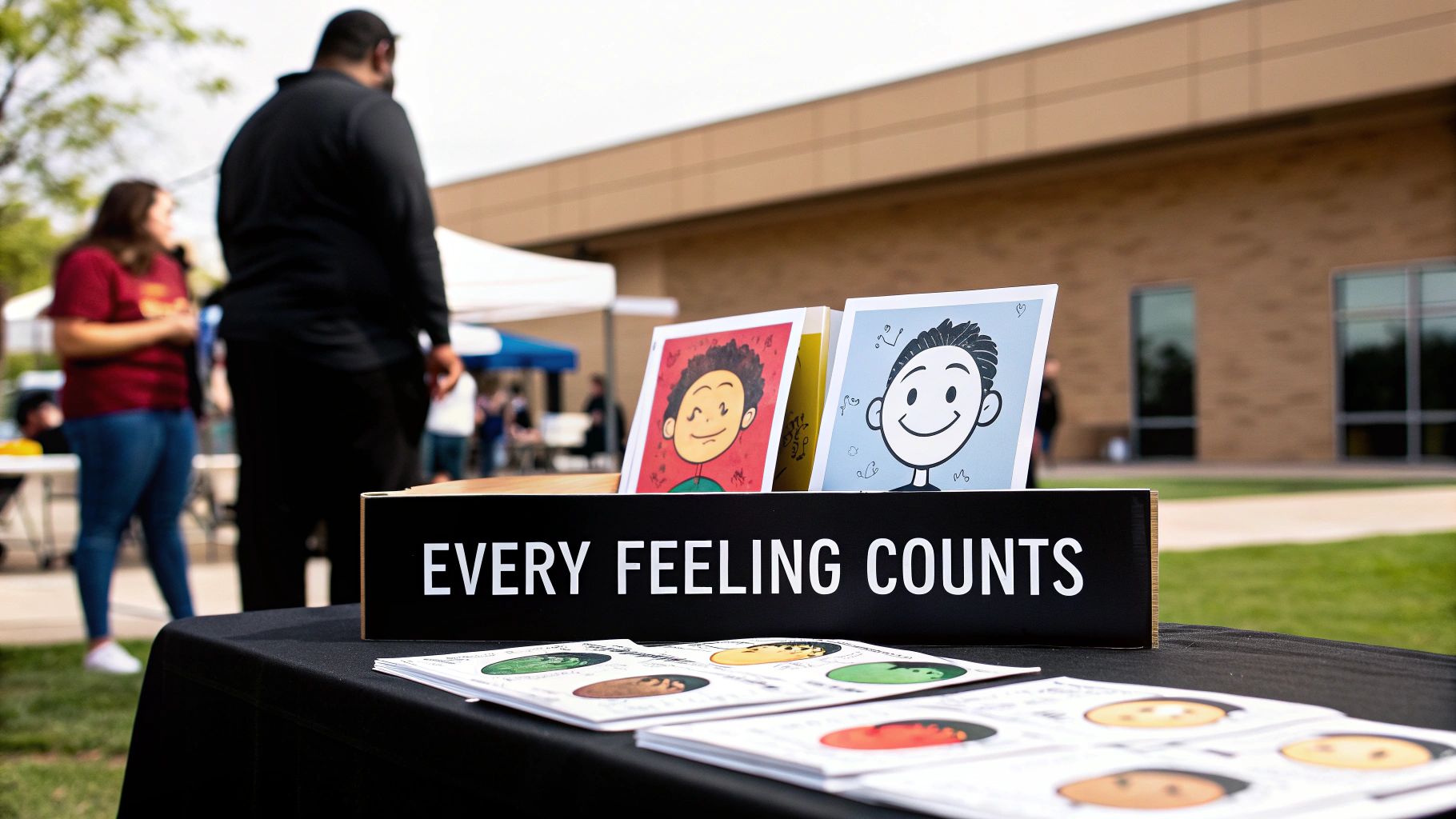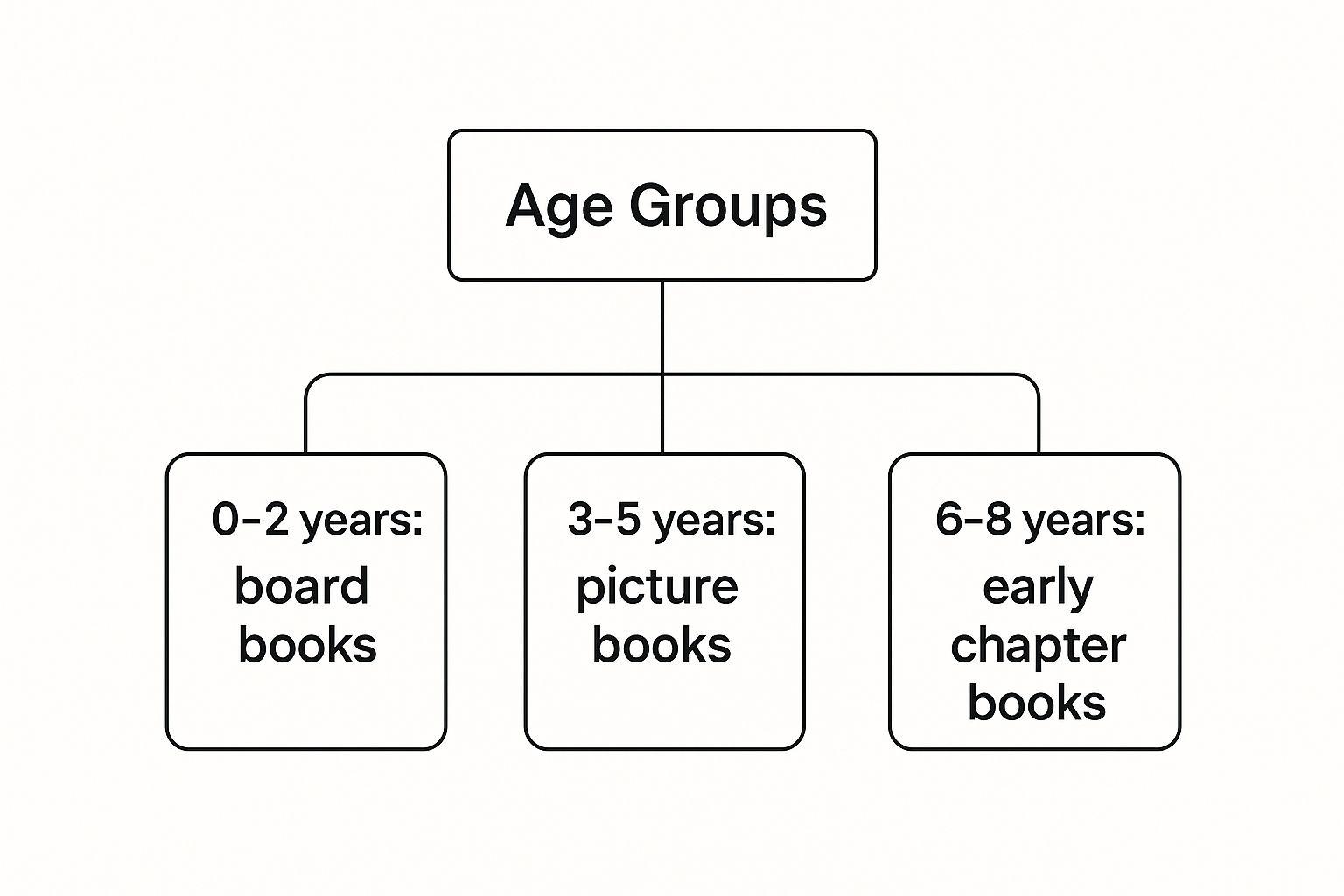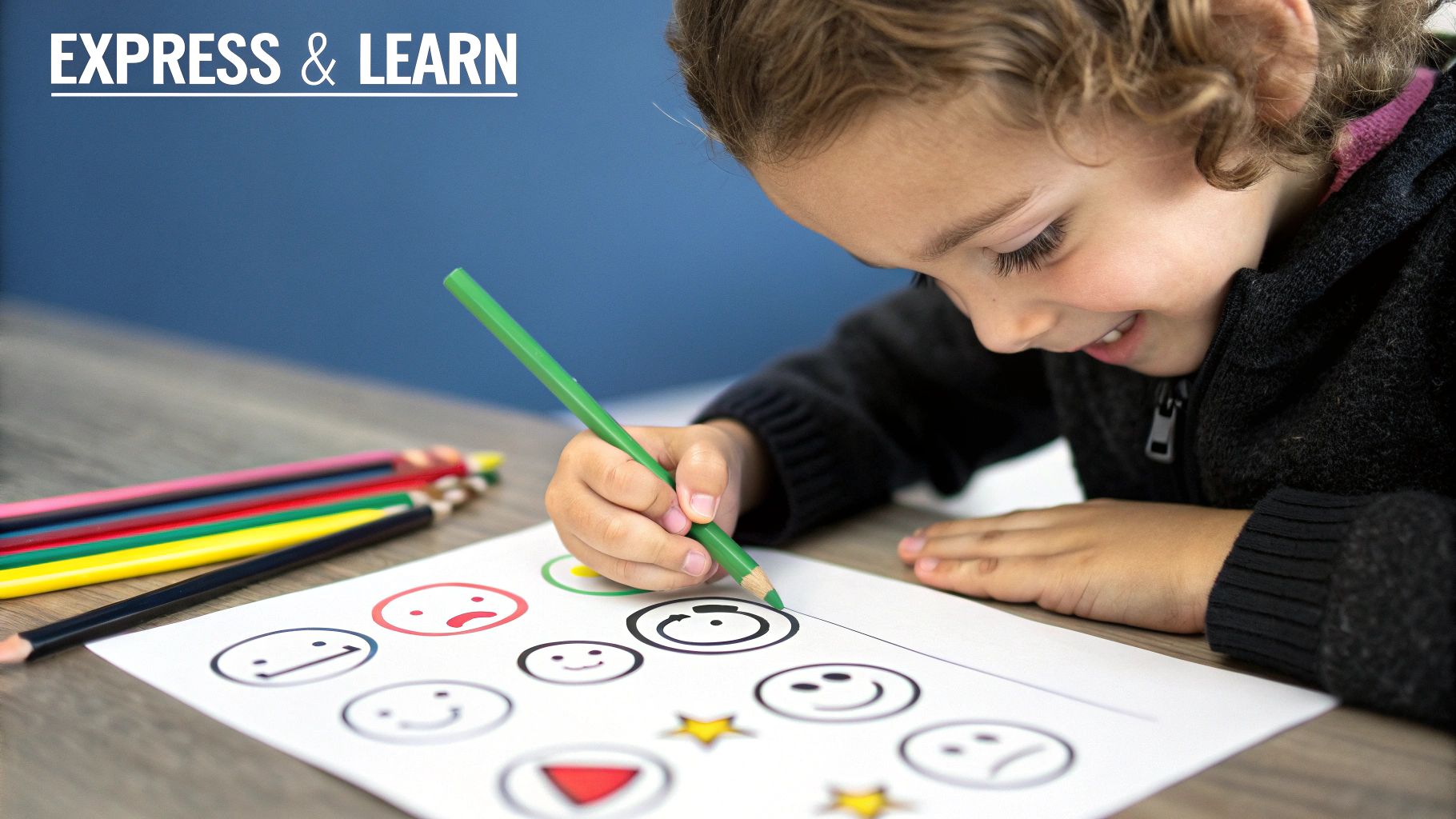
A Parent's Guide to Feelings Books for Children
Share
In a world where we all want our children to be happy and resilient, understanding emotions can sometimes feel like trying to solve a tricky puzzle. That's where feelings books for children come in. They're so much more than just stories; they act as little guides, helping children put names to their big feelings and showing them they're not alone in what they experience. These books are a gentle way to start conversations that can build a lifetime of emotional strength.
Why Every Child Needs a Library of Feelings

Childhood has always had its emotional ups and downs, but today's children are navigating some unique pressures. From playground politics to the constant influence of social media, the world they're growing up in is complex and ever-changing. This makes looking after their emotional wellbeing more important than ever.
The statistics around children's mental health here in the UK are a real wake-up call. It's estimated that one in five children aged 8-16 now has a probable mental health problem. This highlights a clear and urgent need for tools that support emotional development right from the very beginning, helping to build resilience against modern pressures.
Building a Foundation of Emotional Literacy
This is exactly where feelings books play such a vital role. They aren't just a quick fix to distract a child from a tantrum; they're about building a core skill known as emotional literacy. It’s the ability to recognise, express, and handle emotions in a healthy way.
By giving children a shared vocabulary, these stories create a bridge between what a child is feeling inside and their ability to talk about it. When a character feels 'fizzy' with anger or has a 'grey cloud' of sadness, it makes those big, abstract concepts feel real and relatable to a young mind.
For parents and carers, these books offer a gentle script to open up what can be difficult conversations. Instead of asking a quiet child, "What's wrong?", you could try, "Do you ever feel like the little bear in this story?". It’s a softer, indirect approach that can create a safe space for them to share. You can learn more about this crucial skill in our detailed guide on what is emotional literacy.
A Gentle Disclaimer
It's really important for me to state that I'm not a mental health professional. The advice and book ideas in this article come from my own experience and research, and they're here to help families nurture emotional wellbeing through stories.
If you have serious concerns about your child's mental health, behaviour, or emotional state, it is always best to seek professional advice from your GP or a qualified child psychologist. These books are a wonderful tool to have in your parenting kit, but they are no substitute for professional support when it's needed.
Understanding the Power of a Story

Stories have this incredible way of getting inside a child's head, making those big, confusing feelings feel a lot less scary and much easier to understand. The very best feelings books for children do something quite magical: they act as both a mirror and a window for a child’s emotional world.
Think of it as a mirror. These books show a child their own life reflected back at them. When a character in a story gets that hot, prickly feeling of anger, or has a tummy full of wobbly worries, a child sees themselves in that character. It’s an incredibly powerful moment of recognition that tells them, "Hey, what you're feeling is normal. Other people feel this way, too."
At the same time, these stories are a window into how other people feel. This is where empathy begins to bloom. By seeing why a character is sad or frustrated, a child starts to connect the dots between what happens and how it makes someone feel, which is a massive step towards understanding their friends and family on a deeper level.
Giving Emotions a Name
One of the biggest psychological wins from reading feelings books is that they give families a shared language to talk about emotions. Abstract feelings like anxiety or disappointment are really tricky for little minds to grab hold of, let alone discuss. But books can give these feelings a name, a shape, and even a colour.
A story might describe anger as a 'red monster' or anxiety as 'fizzy feelings'. This kind of simple metaphor can be a complete game-changer at home. A child who might have previously just lashed out can suddenly say, "My red monster is getting really big," which gives you a crucial window to step in and help them calm down before the tantrum hits.
This shared language creates a bridge for real communication. It can turn a moment that might have ended in conflict into a chance to connect and learn together. The focus shifts from seeing 'bad behaviour' to understanding the real emotion driving it.
From Storytime to Real Life
The journey a child goes on with a feelings book is a gradual one. It starts with spotting an emotion in a fictional character, and slowly, they begin to recognise that same feeling in themselves and the people around them.
The real magic happens when a story's theme connects directly to a child's life. A book about a squirrel who is afraid of the first day of school can open up a vital dialogue about your own child's anxieties, making their abstract fears tangible and manageable.
This process turns reading from a passive activity into a practical tool for emotional regulation. Just look at how it can play out in everyday situations:
- A playground disagreement: After reading a book about sharing, you could ask, "Remember how the two bears felt when they both wanted the same toy? Did you feel a bit like that today when you and Leo both wanted the swing?"
- Feeling left out: A story about a character being excluded from a game gives you a gentle way to talk about the sadness and loneliness your child might have felt at a party.
- Coping with disappointment: When a promised trip to the park is rained off, you can bring up a story where a character had to deal with a similar let-down. It’s a great way to remind your child of the coping strategies they learned from the book.
These little conversations, all sparked by a simple story, are the very building blocks of emotional resilience. They teach children that all their feelings are okay and give them the tools they need to navigate life's inevitable emotional bumps.
Choosing the Right Feelings Books for Every Age
Picking out the right feelings books for children is a bit like choosing a pair of shoes; what fits a toddler won't work for an eight-year-old. A child's grasp of emotions grows and changes over time, so the books we share with them need to match where they are developmentally to really hit home.
You wouldn't try to teach algebra to a child just learning to count, and in the same way, you wouldn't hand a book about complex social anxiety to a two-year-old. The idea is to meet them where they are with stories and pictures that make sense in their world. This way, the book becomes a helpful tool, not a source of confusion.
This image gives you a quick look at how the types of books change as children get older.

It’s clear how things shift from simple, tough board books for little ones to more detailed picture books and, eventually, early chapter books as they grow.
Books for Toddlers (0-3 Years)
For our youngest children, simplicity is absolutely everything. The world is a whirlwind of sensory experiences, and their emotional landscape is just starting to form. The goal here isn't deep storytelling but simply introducing the building blocks of feelings.
Look for books that are:
- Durable: Think sturdy board books that can handle being chewed, grabbed, and turned over by enthusiastic little hands.
- Visually Clear: Bright, simple illustrations with really expressive faces are key. A drawing of a smiling face or a crying face is something they can recognise instantly.
- Focused on One Idea: Ideally, each page or spread should zero in on a single, core emotion like happy, sad, or angry.
The main aim is to build a basic vocabulary. Words like 'happy', 'sad', and 'mad' are the very first bricks in the wall of emotional literacy. For more tailored ideas, check out our recommendations for the best books about feelings for toddlers.
Books for Preschoolers (3-5 Years)
When children hit the preschool years, their world suddenly gets much bigger. They're starting to figure out friendships, sharing, and the odd playground squabble. Their ability to follow a story with a proper beginning, middle, and end is also growing, which makes it the perfect time to introduce books with a bit more emotional depth.
At this stage, the best books often feature:
- Relatable Characters: Animals or children who are dealing with classic preschooler problems, like feeling shy or getting frustrated when someone takes their toy.
- Simple Plots: The stories should still be easy to follow, showing a clear link between something happening and how a character feels about it.
- Introduction to Coping: Many books for this age start to bring in simple, practical strategies, like taking a deep breath or finding a quiet spot to calm down.
This is your chance to start exploring feelings beyond the basics, like worry, excitement, jealousy, and surprise. The stories offer a safe, made-up space for them to explore these bigger emotions from a distance.
Books for the Early School Years (5-8 Years)
Once children start primary school, their social and emotional lives get a whole lot more complicated. They're suddenly dealing with peer pressure, schoolwork, and a growing awareness that other people have feelings, too. The books for this age group can start to reflect this new complexity.
This is the age where stories can act as a powerful 'window' into the minds of others, building the critical skill of empathy. A child can read about a character who feels embarrassed and begin to understand what that feeling is like for someone else.
Look for books with more detailed stories, characters who feel mixed emotions (like feeling excited and nervous at the same time), and plots that explore social situations like arguments with friends, feeling left out, or handling disappointment.
To help you find the perfect fit, here's a simple guide that breaks down what to look for at each developmental stage.
Age-Appropriate Feelings Books Guide
| Age Group | Key Focus | Book Characteristics | Example Theme |
|---|---|---|---|
| Toddlers (0-3) | Naming basic emotions | Board books, simple illustrations, single-emotion concepts | "The baby is happy." |
| Preschoolers (3-5) | Understanding emotional causes | Picture books, relatable characters, simple narratives | "The bear is sad because he lost his toy." |
| Early School (5-8) | Empathy and social situations | Early chapter books, complex characters, mixed emotions | "She felt worried about her first day at a new school." |
At the end of the day, choosing the right book comes down to knowing your child. When you match the story to their stage of development, you’re not just giving them a book; you’re giving them a powerful tool to understand themselves and the world around them.
How to Read Feelings Books for Maximum Impact
Simply reading the words in a feelings book for children is only half the story. The real magic happens when you turn story time into a proper conversation. This simple shift transforms a passive reading session into a powerful moment of connection and learning.
The idea is to use the book as a launchpad for discussion, not just a bedtime story to get through. By doing this, you create a safe, supportive space where your child feels comfortable exploring their own emotions and asking questions.
Create a Cosy and Safe Reading Space
Before you even open the book, have a think about the environment. Reading about feelings requires a sense of security and trust, so creating the right atmosphere is your very first step.
Find a comfortable, quiet spot away from distractions like the telly or tablets. Snuggle up on the sofa with a blanket or build a cosy fort with cushions on the floor. That physical closeness is really reassuring and signals to your child that this is special time, just for the two of you. It makes them so much more likely to open up.
Pause and Ask Open-Ended Questions
The key to unlocking a book's potential is to treat it like a chat. Instead of ploughing through from cover to cover without a break, make a habit of pausing every few pages to check in.
Try to avoid simple 'yes' or 'no' questions. Instead, use open-ended prompts that encourage them to think and share. These gentle questions act as a bridge between the character's feelings and your child's own experiences.
You could try asking things like:
- "How do you think the little bear is feeling on this page? What makes you say that?"
- "Have you ever felt that big, fizzy feeling in your tummy like the squirrel has?"
- "What do you reckon might happen next to make the character feel better?"
This approach does more than just test their comprehension; it validates their own emotional world. For more ideas on making story time a two-way street, explore our guide on the benefits of interactive children's books.
Connect Stories to Real Life
To make the lessons from feelings books truly stick, it's vital to connect the fictional world of the story to your child's real-life experiences. This helps them see that the emotions they read about aren't just for characters in books—they happen to everyone, including them.
When a character feels frustrated because their tower of blocks fell over, you can say, "That's a bit like when you were building your LEGO castle yesterday, isn't it? It can feel really annoying when that happens." This simple act of linking the story to their life shows them you understand their feelings, and that those feelings are completely valid.
This technique of connecting fiction to reality is one of the most effective ways to build emotional intelligence. It helps a child organise their memories and feelings, giving them a framework for understanding their own emotional reactions in the future.
Use Reading for Relaxation
Beyond the conversation, the act of reading itself can be a powerful relaxation tool. Recent findings from the National Literacy Trust highlight just how important reading is for children's wellbeing in the UK. Their 2023 survey showed that 59.4% of children said reading helps them relax, and 46.0% said it makes them feel happy. You can discover more insights about reading and mental wellbeing from their full report.
You can lean into this by pairing reading time with simple calming techniques. If you're reading a book where a character takes deep breaths to calm down, why not practise it together? Pause the story and say, "Let's try that, too. Let's take a big, slow breath in through our nose... and let it all out through our mouth." Another simple technique is '5-4-3-2-1 grounding': pause to name five things you can see, four you can touch, three you can hear, two you can smell, and one you can taste. This anchors them in the present moment, gently easing anxiety.
Our Top Recommended Feelings Books for Children

Trying to pick from the endless sea of feelings books for children can feel a bit much, but a handful of titles have rightfully earned their place as trusted favourites in UK homes. These aren't just lovely stories; they are genuinely practical tools that open the door to those all-important conversations. We've put together a selection of our go-to books that really get to the heart of the big, messy world of emotions.
Each one offers a unique mirror for children to see their own feelings in, helping them feel seen and a little less alone. Think of these stories as a gentle starting point, giving you and your child a shared language to talk about everything from a tiny flutter of worry to a full-blown storm of anger.
The Colour Monster by Anna Llenas
- Key Emotions: Confusion, Happiness, Sadness, Anger, Fear, Calm
- Ideal Age Range: 3-7 years
This internationally beloved book is a true visual delight. It introduces us to a sweet monster whose feelings are all jumbled up in a big, confusing mess—a sensation that many young children know all too well. The story beautifully follows the monster as it carefully sorts each emotion into a different coloured jar, giving a tangible, vibrant identity to otherwise abstract feelings.
What makes The Colour Monster so brilliant is its pure simplicity. The clever pop-up illustrations and clear colour associations—yellow for happy, blue for sad—make the idea of emotional organisation accessible even for the littlest ones. It’s the perfect first step on the road to emotional literacy.
Ruby Finds a Worry by Tom Percival
- Key Emotions: Anxiety, Worry, Loneliness
- Ideal Age Range: 3-7 years
Ruby is a happy, curious little girl until, one day, she finds a Worry. It starts off small, but the more she tries to ignore it, the bigger and bigger it gets. Soon, it's so huge it stops her from doing all the things she loves. The real breakthrough happens when she spots another child with their very own Worry and learns that talking about it is the secret to making it shrink.
This book is a fantastic way to help children see their anxiety as something separate from themselves. It teaches an absolutely crucial lesson: sharing a worry is the most powerful way to tame it. The gorgeous illustrations perfectly capture how anxiety can loom large in a child's world, delivering a gentle yet profound message about the power of connection.
The Boy with Big, Big Feelings by Britney Winn Lee
- Key Emotions: Empathy, Sensitivity, Overwhelm
- Ideal Age Range: 4-8 years
This stunningly illustrated story follows a boy whose feelings are so enormous they burst right out of him—as a flood of tears when he's sad or a beaming grin when he's happy. He feels everything so deeply and starts to worry that his huge emotions are just too much for everyone else. The story beautifully celebrates his emotional depth, showing him that his sensitivity is a real strength, not a weakness.
It’s an essential read for validating the experience of highly sensitive children. The book normalises intense emotions and encourages children to embrace their feelings without shame, fostering self-acceptance and empathy.
When Sophie Gets Angry—Really, Really Angry... by Molly Bang
- Key Emotions: Anger, Frustration, Self-Regulation
- Ideal Age Range: 3-7 years
When Sophie’s sister snatches her toy gorilla, she gets incredibly angry. The book uses powerful, fiery illustrations to show her rage building as she runs outside, has a good cry, and climbs a tall tree to be alone. Slowly, the quiet world around her helps her calm down until she feels ready to go back home.
This book is brilliant because it never judges Sophie for being angry. Instead, it validates the feeling and models a healthy way to cope: find a safe space, feel the emotion, and let yourself calm down naturally. It’s a practical guide to self-regulation that you can easily refer back to when your own child is feeling overwhelmed by it all.
Supporting Conversations Beyond the Book
Of course, these feelings books for children are just one part of a much bigger picture. The conversation around mental health is, thankfully, becoming more and more normalised, and we're seeing that reflected in other parts of our children's lives. For instance, the rise of mental health apparel for children—t-shirts and jumpers with positive affirmations like "It's Okay To Feel" or "Be Kind To Your Mind"—is another wonderful way to reinforce these messages day-to-day.
It’s all part of a collective effort to build a world where talking about feelings is as normal as talking about a grazed knee. By combining powerful stories with everyday reminders, we’re giving our children the tools they need to build a resilient and emotionally healthy future.
Building a Mentally Healthy Future, One Book at a Time
Guiding a child through the complicated world of their own emotions is one of the most important things any parent can do. The feelings books for children we’ve looked at are so much more than just simple stories; they're genuine tools for building emotional intelligence and resilience that will last a lifetime. Every book is a chance to start a vital conversation, strengthening your family bond and looking after your child’s mental wellbeing from the very beginning.
This early emotional education has a powerful ripple effect that goes far beyond the home. With poor mental health costing UK businesses up to £56 billion every year due to lost productivity and absenteeism, nurturing these skills in childhood isn't just a family matter—it's a societal one. In a world where social media can often present a filtered, unrealistic version of life, books offer a quiet, screen-free space for authentic connection. To create a truly well-rounded approach to your child's development, consider pairing this emotional learning with hands-on Montessori educational toys.
By embracing these resources, you're giving your child the vocabulary and understanding they need to navigate life's inevitable ups and downs. You’re not just reading a book; you’re building a healthier future.
Of course, while these books are fantastic aids, they are not a replacement for professional guidance. If you ever have serious concerns about your child's mental health, please don't hesitate to speak with your GP.
Frequently Asked Questions
When you start exploring the world of emotions with your little one, it's natural for questions to pop up. Here are some of the things parents often wonder about as they bring feelings books for children into their family's story time.
At What Age Should I Start Reading Feelings Books to My Child?
Honestly, it's never too soon. For babies and toddlers (0-2 years), think simple. Chunky board books with big, expressive faces and single words like 'happy' or 'sad' are just the ticket. It's all about helping them connect the dots between a word and a facial expression, laying the very first bricks of emotional understanding.
As they move into their preschool years (3-5 years), you can bring in books with straightforward stories where characters feel things and react. The real secret is just to match the complexity of the book to where your child is at developmentally.
What if My Child Doesn't Want to Talk About the Feelings in the Book?
First off, don't worry. This is completely normal, so the last thing you want to do is push them. The whole point is to create a safe, no-pressure zone. If your child is quiet, trust that they're still taking in the story and its message.
Just reading the book together is a huge step. It normalises the emotion and quietly shows them that it's okay to feel a certain way, even if they aren't quite ready to talk about their own experiences.
Keep reading the books and leave the door open for conversation. You can even model it yourself by sharing something small. "That little bear felt worried, didn't he? I sometimes feel worried when I have a big day at work." This gentle way of connecting the story to real life often encourages them to open up when they feel comfortable.
Are There Feelings Books That Deal with More Complex Topics?
Absolutely. The world of feelings books for children has grown so much, and now there are some incredible books that gently tackle life's tougher moments. Many brilliant authors have found age-appropriate ways to explore difficult subjects, giving children a way to process what’s happening.
You can find books created specifically to help with:
- Grief and Loss: These stories can be a real comfort, helping a child make sense of the sadness that comes with losing a pet or a family member.
- Family Changes: There are wonderful books designed to navigate topics like a divorce, parents separating, or a new baby brother or sister arriving.
- Big Transitions: Many stories focus on the anxieties that come with starting a new school or moving to a new house.
These kinds of books are worth their weight in gold. They provide a shared language and a starting point for conversations about things that are often incredibly hard to find the right words for.
Here at Little Fish Books, we believe every story is a stepping stone to a deeper emotional understanding. Take a look at our hand-picked collection of books and resources, all designed to help children and families explore feelings together. Visit us at https://thatsokay.co.uk to find the perfect book for your little one.
